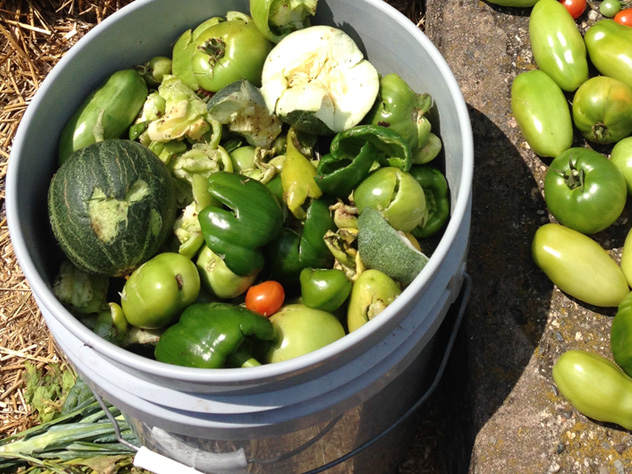
A couple of weeks ago, Rob arrived at the Huss Project to find the yard around the community garden strewn with vegetables. We’d been battling a woodchuck nemesis, and also a possum, but this was too sophisticated for those critters, if you can call throwing tomatoes at the windows “sophisticated.” Let’s just say, it was obvious that this damage was the responsibility of two-legged, rather than four-footed, creatures.
I was at work when I started receiving a flurry of frustrated texts, a play-by-play report of the damages, and I could feel the familiar sense of despair begin to tie knots in my stomach. This time was not our first experience of vandalism at the Huss Project. In the past, we’ve arrived to find “Suck It” spray painted on the the front of the school (with a backwards “S” — a bit of levity, at least), the new garden shed tipped over with the roof broken off, the window of the sheltered side entrance broken through with a chunk of asphalt. Each time re-opens up scarred wounds of sadness and anger. Why do we sacrifice to do all of this work, only to have it destroyed again and again, for no good reason? Do the benefits really outweigh the costs?
On my way from work to the Huss Project to join kids for our last lunch of the summer, I searched for ways to mitigate against the natural impulse to quit. Where I landed, at that moment in the car, was that they were just vegetables. On the scale of trauma, this was pretty low. No one had been injured or killed, no irreparable damage had been done to the historic structure of the school. While smashed-up squash and tomatoes and peppers would no longer serve to feed our hungry neighbors, they could still feed the microorganisms in our compost pile, so they would not go entirely to waste.
And yet, as some of my gardening compatriots would later point out, these weren’t “just” vegetables. Each tomato, each pepper, each squash is a symbol of what we value and what we strive to offer our community. The destruction of these objects, even if it is more careless than malicious, is an attack on an attempt at goodness — at abundance, sharing and hard work. And our educated guess at who was responsible also makes us realize that the outer destruction of stuff is a manifestation of inner instability and anxiety.
So we made a point of talking with some of our regular kids at lunch that day and at the last Community Fun Night of the summer about what the vandalism meant to us and how much it hurts to arrive at the Huss Project to see our own work and the work of our many volunteers strewn across the yard. We were very careful not to blame them individually, but we did want them to know that these kinds of actions have real consequences in terms of the amount of food we have to share with our hungry neighbors.
It helps to get back to work: to play with chatty three-year-olds over lunch, to tie up the tomato plant that’s grown over six feet tall, to harvest the miniature cantaloupes that have finally ripened in the late summer heat, to take silly photos the tiny tree frogs that have taken up residence in the blueberry patch. And it helps to know that we are not alone in both our lament and our hopefulness, as this timely piece from our friends over at the Mustard Seed Associates so eloquently reminds us.
At our best, maybe we remember that we do this work not in spite of the destruction, but because of it — because the work of healing our earth and our communities is still needful, is still hard, is still the only way to move forward with ridiculous joy.



